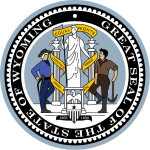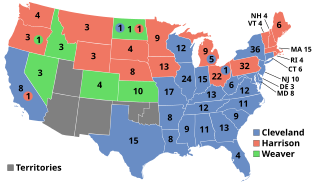
The 1892 United States presidential election was the 27th quadrennial presidential election, held on Tuesday, November 8, 1892. In the fourth rematch in American history, the Democratic nominee, former president Grover Cleveland, defeated the Republican incumbent, President Benjamin Harrison. Cleveland's victory made him the first and, to date, the only person in American history to be elected to a non-consecutive second presidential term. It was also the first of two occasions that incumbents were defeated in consecutive elections—the second being Gerald Ford's loss to Jimmy Carter in 1976, followed by Carter's loss to Ronald Reagan in 1980. To date, it is the only election in which both major party nominees had served as president.

The 1896 United States presidential election was the 28th quadrennial presidential election, held on Tuesday, November 3, 1896. Former Governor William McKinley, the Republican nominee, defeated former Representative William Jennings Bryan, the Democratic nominee. The 1896 campaign, which took place during an economic depression known as the Panic of 1893, was a political realignment that ended the old Third Party System and began the Fourth Party System.
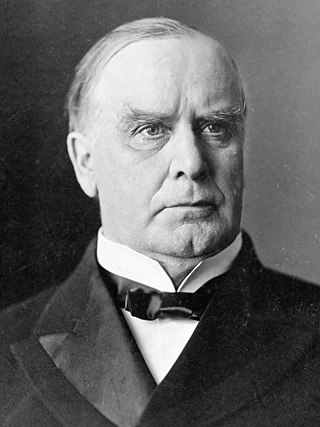
The 1900 United States presidential election was the 29th quadrennial presidential election, held on Tuesday, November 6, 1900. In a re-match of the 1896 race, incumbent Republican President William McKinley defeated his Democratic challenger, William Jennings Bryan. McKinley's victory made him the eighth president to win consecutive re-election and first since Ulysses S. Grant accomplished the same feat in 1872. Until 1956, this would be the last time in which an incumbent Republican president would win re-election after serving a full term in office. This election saw the fifth rematch in presidential history but the first to produce the same winner both times; neither would occur again until 1956.

The People's Party, also known as the Populist Party or simply the Populists, was an agrarian populist political party in the United States in the late 19th century. The Populist Party emerged in the early 1890s as an important force in the Southern and Western United States, but declined rapidly after the 1896 United States presidential election in which most of its natural constituency was absorbed by the Bryan wing of the Democratic Party. A rump faction of the party continued to operate into the first decade of the 20th century, but never matched the popularity of the party in the early 1890s.

Marion Butler was an American politician, farmer, and lawyer. He represented North Carolina in the United States Senate for one term, serving between 1895 and 1901. At the time, he was a leader of the North Carolina Populist Party, and also affiliated with the Democratic Party and the Republican Party at different points in his career. He was the older brother of George Edwin Butler.

John Eugene Osborne was an American physician, farmer, banker, and politician who served as the 3rd governor of Wyoming and United States representative as a member of the Democratic Party.
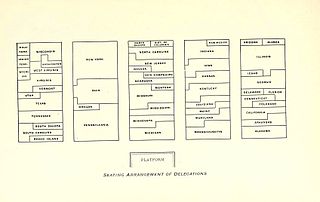
The 1896 Democratic National Convention, held at the Chicago Coliseum from July 7 to July 11, was the scene of William Jennings Bryan's nomination as the Democratic presidential candidate for the 1896 U.S. presidential election.

Claude Matthews was an American politician who served as the 23rd governor of the U.S. state of Indiana from 1893 to 1897. A farmer, he was nominated to prevent the loss of voters to the Populist Party. The Panic of 1893 occurred just before he took office, leading to severe economic problems during his term. Republicans took the Indiana General Assembly in the 1894 mid-term election and repudiated many of the Democrats' laws, leading to violence in the assembly. A popular party figure when he left office, he was a nominee to run for president at the 1896 Democratic National Convention, but lost his bid for the nomination to William Jennings Bryan.
The Silver Party was a political party in the United States active from 1892 until 1911 and most successful in Nevada which supported a platform of bimetallism and free silver.
The Wyoming Democratic Party is the affiliate of the Democratic Party in Wyoming, headquartered in Cheyenne. The party was strong during Wyoming's territorial days, but suffered a decline in its early statehood. It rose to prominence again from the 1930s to the 1950s before experiencing another decline.

In 1896, William Jennings Bryan ran unsuccessfully for president of the United States. Bryan, a former Democratic congressman from Nebraska, gained his party's presidential nomination in July of that year after electrifying the Democratic National Convention with his Cross of Gold speech. He was defeated in the general election by the Republican candidate, former Ohio governor William McKinley.

The 1896 South Dakota gubernatorial election was held on November 3, 1896. Incumbent Republican Governor Charles H. Sheldon declined to run for re-election to a third term. Former Secretary of State Amund O. Ringsrud was nominated as Sheldon's replacement at the Republican convention. Ringrud's main opponent was businessman Andrew E. Lee, who was nominated by a makeshift coalition of Populists, Free Silver Republicans, and Democrats. In the general election, Lee narrowly defeated Ringsrud, the first defeat for the Republican Party in a gubernatorial election since statehood.

The 1892 Wyoming gubernatorial special election was held on November 6, 1892. Republican Governor Francis E. Warren, who was elected in 1890, resigned several weeks into his term after being elected to the U.S. Senate by the state legislature, elevating Secretary of State Amos W. Barber to the governorship and triggering a special election for the balance of Warren's term.

The 1898 Wyoming gubernatorial election was held on November 8, 1898. Incumbent Republican Governor William A. Richards was a candidate for re-election, but he was defeated for renomination at the Republican convention, which instead nominated DeForest Richards. The Democratic Party joined forces with the Free Silver Republicans to jointly nominate former State Representative Horace C. Alger for Governor. The Populist Party, though reduced in influence from earlier elections, nominated E. B. Viall as its candidate. Though the election was closer than 1894, owing in large part to a dramatic reduction in the share of vote received by the Populist nominee, Roberts defeated Alger by a wide margin.

The 1904 Wyoming gubernatorial election was held on November 8, 1904. Shortly after he began his second term in 1903, Governor DeForest Richards died in office, elevating Secretary of State Fenimore Chatterton to the Governorship and triggering a special election in 1904 to fill the balance of Richards's term. Chatterton ran for re-election, but was defeated for renomination at the Republican convention by Bryant B. Brooks. Former Congressman John E. Osborne, the former Territorial Governor, was nominated by the Democratic Party. Aided by President Theodore Roosevelt's landslide victory over Democrat Alton B. Parker in the presidential election, Brooks overwhelmingly defeated Osborne.

A general election was held in the U.S. state of Wyoming on Tuesday, November 6, 1894. All of the state's executive officers—the Governor, Secretary of State, Auditor, Treasurer, and Superintendent of Public Instruction—were up for election. The Republican Party, helped by the strong performance of the Populist Party, which operated as a spoiler to the Democratic Party, won back the governorship and improved its margin of victory in all other statewide offices.

A general election was held in the U.S. state of Wyoming on Tuesday, November 8, 1898. All of the state's executive officers—the Governor, Secretary of State, Auditor, Treasurer, and Superintendent of Public Instruction—were up for election. The Republican Party retained all of the offices up for election, though by reduced margins from 1894 as the Populist Party's performance decreased considerably.
From 1894 to 1900 the North Carolina Republican Party and the Populist Party collaborated via electoral fusion to compete against the North Carolina Democratic Party. This political coalition was dubbed Fusionism.
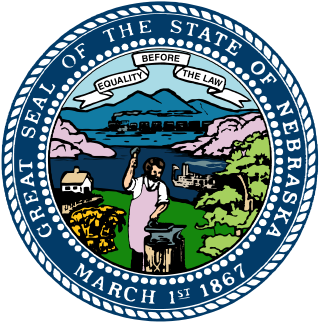
The 1898 Nebraska gubernatorial election was held on November 8, 1898. Incumbent Populist Governor Silas A. Holcomb did not stand for re-election. Populist and Democratic fusion nominee William A. Poynter defeated Republican nominee Monroe Hayward with 50.19% of the vote.

William Anderson Guthrie was an American lawyer and politician. Born in Chatham County, North Carolina, he attended the University of North Carolina at Chapel Hill and served in the Confederate States Army during the American Civil War. After the war, Guthrie married and moved to Fayetteville to practice law. He located his practice to Durham in 1884.

